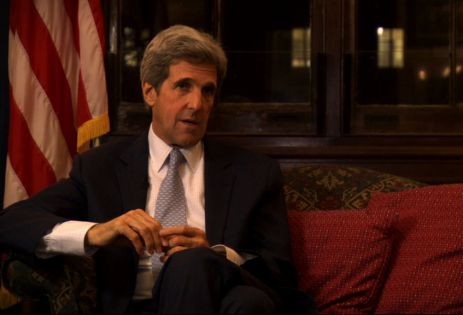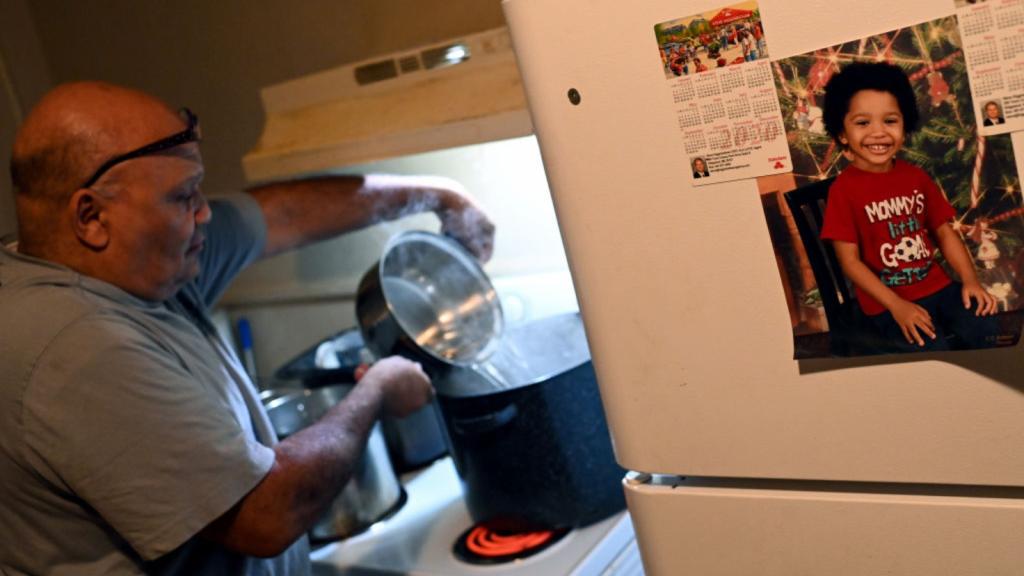Busy day here — started early with some curtain-raising morning television to kick off the discussion a bit about the American Power Act that Joe Lieberman [I-Conn.] and a unique coalition are talking about later today.
But sometimes those morning-show interviews are a bit of a reminder of how much detailed discussion we lose when we’re crammed into a two- or three- or five-minute back-and-forth, which is especially tough on an issue like a comprehensive approach to climate and energy.
Which brings me to why I wanted to come by Grist — because of the in-depth discussions you’ve already had here again and again on this issue.
But — and here’s the but — I don’t want to swing by and just sort of preach to the choir. We’re true believers — we already get the imperative of the threat our addiction to carbon-emitting energy poses. You know the science, you know the reality, and so do I.
So, what I do want to talk about is this: We need to take a deep dive together on the Senate strategy, and on the real details of the bill that make it important for the things you and I care about. So, I hope I bring something new to that discussion that we can use as a jumping-off point.
First, the Senate dynamic — the politics of this place. I want to be candid about this, and I do so with a record on this issue that I think earned me the spurs to say this. We’ve been at this a long time. Al Gore and I held the Senate’s first climate-change hearings in the Commerce Committee way back in 1988. Since then, precious little progress has been made and ground has been lost internationally, all while the science has grown more compelling. I can barely even count any more the number of international summits I’ve attended, or press conferences we’ve held after losing climate-change votes in the Senate where our message was, “Next year, we can get this done — don’t give up on the United States or the Senate.” Two Congresses ago, we had 38 votes for a bill. Last Congress, we had 54 votes for cloture out of 60 needed — and we said then — me, Joe, Barbara Boxer [D-Calif.] — that this Congress we could get to 60 and pass a bill.
So what have we done? A lot of meeting and listening — between me, Joe Lieberman, and Lindsey Graham [R-S.C.], hundreds of meetings one-on-one with our colleagues to find out what they needed to support a bill. And I absolutely believe we’re closer than ever to getting across the finish line — but make no mistake, it remains difficult, even with President Obama in the White House, and even with the House of Representatives having passed their bill by the slimmest of margins last summer. But we’re going full-steam ahead because, in my judgment, this may be the last and certainly the best chance for the Senate to act, especially with the fact that I think the next Senate — given a 2012 presidential campaign added to the dynamic and a lot of new senators — is going to be less likely than this one to find a path to the 60 votes needed for passage. So we’ve got to get it done this year.
Hear me out on this one — you know where I’ve been and continue to be on all the major environmental fights since even before I became a senator. As a lieutenant governor, I focused on acid rain and we laid the groundwork for the successful fight on the Clean Air Act in 1990, with the support of the first President Bush and bipartisan support from Congress. In stark contrast to that effort to find a bipartisan way forward, I led the successful filibuster — against the urging of many in our Democratic caucus — to defeat the second President Bush’s plan to drill in and destroy the Arctic National Wildlife Refuge. I point to these twin examples because I think they’re evidence that I know when to dig in and fight, and I also know when and how to find the path to getting something done across the aisle.
And here’s what I can tell you: A comprehensive climate bill written purely for you and me — true believers — can’t pass the Senate no matter how hard or passionately I fight on it. No, it’s got to be an effort that makes my colleagues — and that has to include Republicans so we can get to 60 — comfortable about the jobs we’re going to create and the protection for consumers and the national security benefits — and it has to address those pieces on their terms. The good news: I think we got that balance right.
So, the straight scoop on the details, the real down-in-the-weeds details:
First and foremost, this bill creates a major — mandatory — pollution-reduction program that sends the needed price signal on carbon, with carbon allowances auctioned in a heavily regulated market that doesn’t allow any speculators access. Only corporations that need the pollution allowances can buy them, period. No bank can swoop in and start speculating. These corporations that buy the allowances can trade them among themselves, but again, no outside entities are allowed, with the minor exception of a few heavily regulated “liquidity providers” who are there to make sure there are always buyers and sellers at any one time. The actions of these providers, however, are tightly controlled, and their profits are extremely limited by the law. There’s no Wild West of speculation possible here, just a strict market only open to those who need it.
It will also be a stable market. The American Power Act creates a hard price collar for the sale of carbon allowances. This will cut down on the volatility of the market, especially in the early days, and give investors a clear signal on future prices. We don’t let this affect the environmental integrity or jeopardize the pollution reductions we’re going for, though. Instead, we hold back a strategic reserve of allowances that we release if the market gets too high to bring down the cost without adding new carbon to our pollution targets.
And, look, creating this pollution-reduction market is incredibly important to do. We absolutely have to send a price signal to move to a new energy economy. Every business leader I talk to confirms this — nothing else will get the job done. Without it, we won’t get the certainty we need in our economy that drives the innovation and investment in the clean energy economy. And without that, we won’t be able to get a real international agreement, with teeth, to confront the crisis of climate change.
Now, we can’t leave American workers exposed, waiting forever for others to join us in the effort to price pollution, because that would force them to compete against countries that have no greenhouse-gas emissions limits. That would just shift pollution abroad rather than reduce it, and in the process, it would cost us jobs. So we’ve included a robust, WTO-consistent border-adjustment mechanism in the bill. It’s pretty simple: Imports from countries that aren’t doing what we’re doing will need to pay a fee at the border or we will give our producers the resources they would need to keep from having their production shifted overseas to avoid the cost of polluting. This will prevent the “carbon leakage” of companies moving production offshore, and it allows American manufacturers to compete on a level playing field with those overseas. And I guarantee that on a level playing field, nobody beats the American worker.
We also want Americans to share in the benefits of this legislation, so the American Power Act — inspired in part by the great work of Sens. Maria Cantwell [D-Wash.] and Susan Collins [R-Maine] — sends the bulk of the proceeds from the sale of the pollution allowances back to the American people directly in the form of rebates. None of it stays with or grows government. Those rebates rise over time until it all goes straight back to Americans.
That’s the heart of the bill. I realize there’s been a lot of discussion about some other aspects of it, so here are some of the other parts of the bill:
-
Clean Air Act: This part of the bill has generated a lot of commentary and reporting recently, and some of it has just missed the mark. Here’s the deal: This bill does not take the EPA out of the mix on regulating carbon. In fact, it strengthens the Clean Air Act by expanding the authority of the EPA and making that authority permanent. First, the entire pollution-reduction program is under the authority of the EPA. The bill specifically requires the EPA to regulate large sources of carbon pollution, but it does not allow it to issue what in many cases would be duplicative regulation of the same sources. Essentially, what the bill says is that EPA should use the program specifically designed for making the deep reductions in carbon pollution called for in the bill. The bill preserves key Clean Air Act tools for sources not in the program, and it calls on EPA to continue setting tough emission standards to reduce global-warming pollution from cars and trucks. It also continues EPA’s ability to set performance standards for old, dirty power plants to make sure they clean up.
-
Offshore drilling: We’re in the middle of a catastrophe in the Gulf, and it’s important that we fully understand the implications as we move forward. This bill starts that process by tightening current federal law and implementing two major reforms. First, any state can veto drilling less than 75 miles off its border. Second, any new rig will have to be studied for the environmental impact of any potential spill, and any state that is found to be at risk can veto that drilling.
-
State laws: The long-standing efforts of states like California to implement innovative programs around vehicle emissions and other programs will not be affected. The bill does make clear that carbon is a national problem, and that the national policy on carbon needs to be the law of the land. But outside of that specific area, states are still free to pursue the policies that they wish. I’ve talked with [Massachusetts] Gov. Deval Patrick about this — Massachusetts has been one of the states ahead of the curve and our bill rewards them — but like with acid rain, these governors know we ultimately need a national solution.
So — one more time – would I design every piece of this legislation exactly as it is if I only had to get my vote? Of course not. But that’s not the way democracy works. The Senate — and our caucus — is a very diverse coalition, from coastal states to Midwestern states to states with large coal reserves. Sixty votes is a tough coalition to put together.
But our planet can’t wait for the perfect bill. We need to get a really good bill now, one that reduces carbon pollution and puts us on a path to a clean energy future. And if we do this, I know we can get a tough international agreement to deal with this global problem. Those are the two things I remind myself of every day when it comes to this bill. You’ve got to keep your eye on the prize. Bottom line: We’re at a crossroads. On one path is clean energy, a more stable climate, and a more prosperous economy with America back in control of our own energy, generating good clean-energy jobs. On the other is the status quo, which is unsustainable. Keep that in mind when you look at this bill and engage in the debate.


